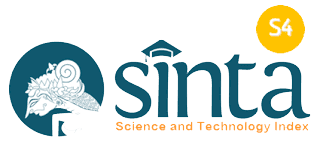Payment System for Official Travel Expenses at the Office of the Jeneberang Saddang River Basin and Protected Forest Management Center
(1) Politeknik LP3I Makassar, Indonesia
(2) Universitas Muhammadiyah Makassar, Indonesia
(3) Politeknik LP3I Makassar, Indonesia
(4) Universitas Hasanuddin, Indonesia
(*) Corresponding Author
DOI: https://doi.org/10.26858/pdr.v5i2.31782
Abstract
Efforts to expedite the financial administration of an office certainly require a good payment system. An efficient payment system certainly realizes the implementation of financial administration that is able to facilitate every activity. The purpose of the study was to determine the payment system for the Jeneberang Saddang River Basin and Protected Forest Management Center (Indonesia: Balai Pengelolaan Daerah Aliran Sungai dan Hutan Lindung Jeneberang Saddang / BPDASHL). The research approach uses descriptive qualitative. The financial administration management of business travel applies two payment systems, namely the first official travel payment system is the Lumpsum payment system where employees traveling on business will receive a certain amount of money which is paid at once. And the second is the At-Cost System where employees take official trips and receive a certain amount of money in accordance with the available evidence and must follow procedures that are in accordance with their respective official travel expense payment systems so that official trips run effectively and efficiently.
Keywords
Full Text:
PDFReferences
Al-Swidi, A. K., Gelaidan, H. M., & Saleh, R. M. (2021). The joint impact of green human resource management, leadership and organizational culture on employees’ green behaviour and organisational environmental performance. Journal of Cleaner Production, 316, 128112. https://doi.org/https://doi.org/10.1016/j.jclepro.2021.128112
de Villiers, C., Kuruppu, S., & Dissanayake, D. (2020). A (new) role for business – Promoting the United Nations’ Sustainable Development Goals through the internet-of-things and blockchain technology. Journal of Business Research. https://doi.org/https://doi.org/10.1016/j.jbusres.2020.11.066
Edwards, G. (2017). Introduction to public administration. Library Press. https://doi.org/10.1111/j.1747-1346.2009.00216-1.x
Fontana, A., & Musa, S. (2017). The impact of entrepreneurial leadership on innovation management and its measurement validation. International Journal of Innovation Science, 9(1), 2–19. https://doi.org/10.1108/IJIS-05-2016-0004
Garcia-Sanchez, I. M., Cuadrado-Ballesteros, B., & Frias-Aceituno, J. (2013). Determinants of Government Effectiveness. International Journal of Public Administration, 36(8), 567–577. https://doi.org/10.1080/01900692.2013.772630
Görgens-Ekermans, G., & Herbert, M. (2013). Psychological capital: Internal and external validity of the Psychological Capital Questionnaire (PCQ-24) on a South African sample. SA Journal of Industrial Psychology, 39(2), 1–13. https://doi.org/10.4102/sajip.v39i2.1131
Hariyono, U. S., Sopyan, Y., Akib, H., Haris, H., Paraga, S., & Astuti, A. (2019). The Effectiveness of the Performance of Civil Servants in the Integrated Service Office in Gowa Regency. 1st International Conference on Advanced Multidisciplinary Research (ICAMR 2018).
Junus, D., Akib, H., Suratman, & Tahir, H. (2016). The recruitment system for civil servants from the perspective of developing organizational capacity in regional government. Social Sciences (Pakistan), 11(24), 5880–5884. https://doi.org/10.3923/sscience.2016.5880.5884
Lægreid, P. (n.d.). Civil Servants’ Perceptions Regarding ICT Use in Norwegian Central Government.
Lengnick-Hall, C. A., Beck, T. E., & Lengnick-Hall, M. L. (2011). Developing a capacity for organizational resilience through strategic human resource management. Human Resource Management Review, 21(3), 243–255. https://doi.org/10.1016/j.hrmr.2010.07.001
Liu, Y., & Bakici, T. (2019). Enterprise social media usage: The motives and the moderating role of public social media experience. Computers in Human Behavior, 101, 163–172. https://doi.org/https://doi.org/10.1016/j.chb.2019.07.029
Ngang, T. K., Prachak, B., & Saowanee, T. (2013). Leadership Soft Skills of Deans in Three Malaysian Public Universities. Procedia - Social and Behavioral Sciences, 93, 1182–1186. https://doi.org/https://doi.org/10.1016/j.sbspro.2013.10.012
Rengifurwarin, Z. A., Akib, H., Jasruddin, & Salam, R. (2018). Snapshot of public service quality in the center for integrated business service (CIBS), cooperative micro small and medium enterprises (CMSME), Maluku province, Indonesia. Journal of Entrepreneurship Education, 21(3).
Vu, T.-V., Vo-Thanh, T., Nguyen, N. P., Nguyen, D. Van, & Chi, H. (2022). The COVID-19 pandemic: Workplace safety management practices, job insecurity, and employees’ organizational citizenship behavior. Safety Science, 145, 105527. https://doi.org/https://doi.org/10.1016/j.ssci.2021.105527
Article Metrics
Abstract view : 183 times | PDF view : 29 timesRefbacks
- There are currently no refbacks.
Copyright (c) 2022 Muhammad Asir, Dewi Puspitasari, Rahmi Rahmi, Annisa Ishmat Asir


































